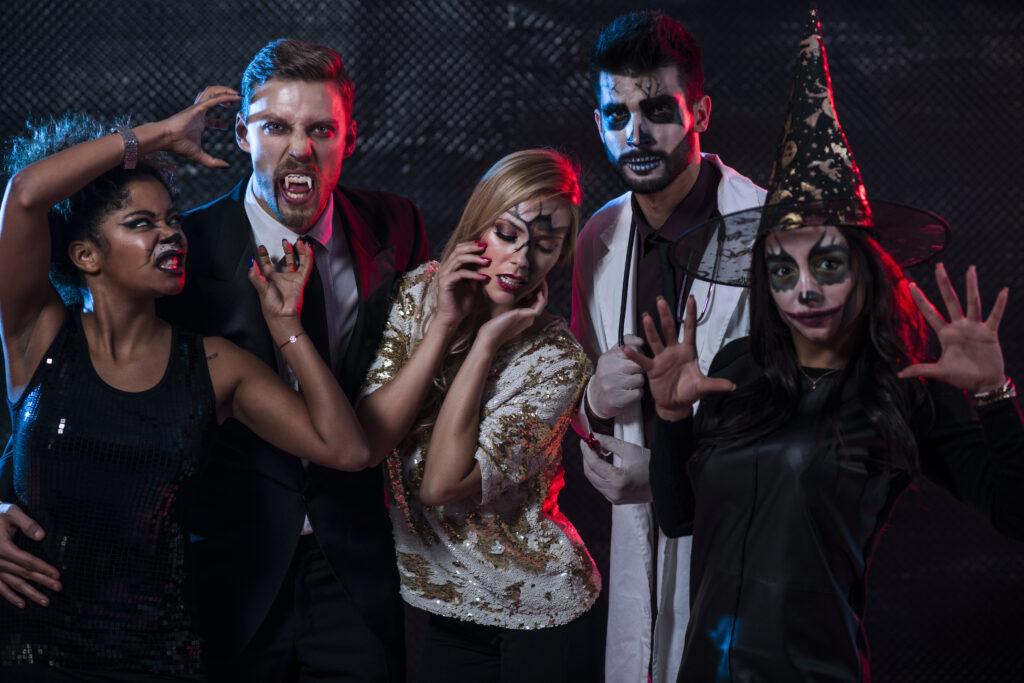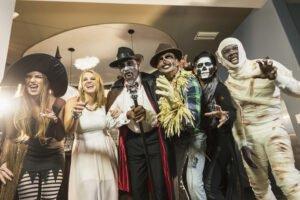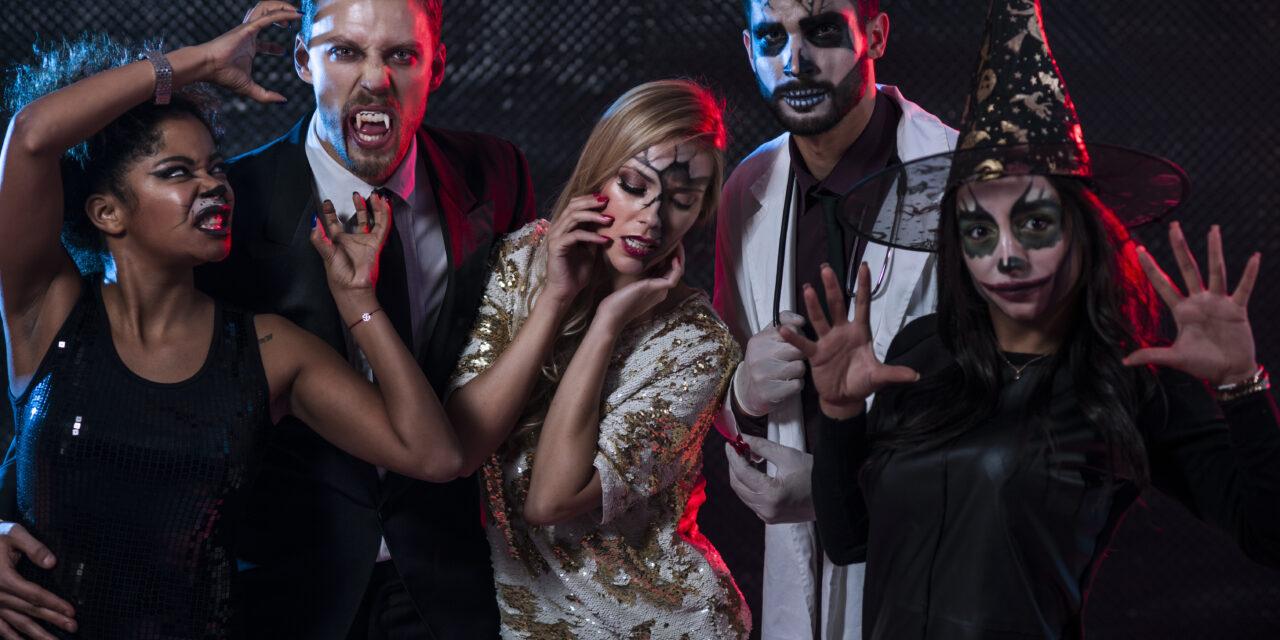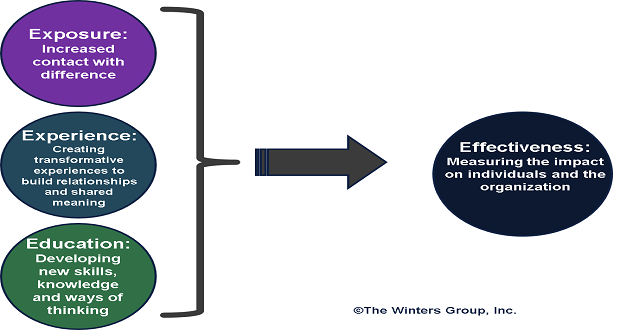
I love Halloween.
It is my absolute favorite holiday.
The candy, the costumes, the beautiful change of the leaves, and, yes, even the scary stories.
While I have a lot of excitement for Spooky Season, this time of year also puts me in a state of reflection. A lot has happened since the beginning of this year. While reflecting back on the year as a whole in Q4 is not a remarkable or unprecedented mental exercise to engage in, what I do find remarkable and unprecedented is the resiliency of my fellow DEIJ practitioners, peers, and colleagues who continue to remain ten toes down in this very important work whilst also withstanding a climate that continues to try to devalue, diminish, and dismiss us. And, I won’t front, that can be a rather exhausting and frightening space to continuously navigate with little insight into what the future holds. Many of the stories surrounding the divestment in DEIJ have had me and my colleagues shook. Just like that thing in the closet you know is there but you can’t quite see, that misplaced bump in the night, or that monster under your bed that certainly isn’t Sully, if, these problems are not properly addressed, then they will continue to plague our workspaces, haunt our intentions, and harm those most impacted.
In the spirit of my favorite season and holiday, let’s look at some of the most scary tropes and themes persisting in our DEIJ spaces today, and the questions we can ask ourselves to better shine a light into the darker corners of our collective understanding.
1. “Let’s Split Up”
 One of the most popular horror movie tropes is the “Let’s split up” trope. You know the deal: the monster, ghoul, goblin, or boogeyman has been wreaking havoc and terror throughout the movie, and at what seems to be the movie’s climax, the group collectively decides that the best idea is to split up – never mind strength in numbers! Of course, as soon as they split up, the boogeyman–doesn’t matter if it’s Ghostface from Scream (1996), Jason Vorhees from Friday the 13th (1980), or Freddy Kruger from A Nightmare on Elm Street (1984) –picks off the victims one-by-one with ease. And as scary (and frustrating) as it is to watch this happen on the silver screen, it’s 10 times worse watching this same trope plague workplace DEIJ efforts.
One of the most popular horror movie tropes is the “Let’s split up” trope. You know the deal: the monster, ghoul, goblin, or boogeyman has been wreaking havoc and terror throughout the movie, and at what seems to be the movie’s climax, the group collectively decides that the best idea is to split up – never mind strength in numbers! Of course, as soon as they split up, the boogeyman–doesn’t matter if it’s Ghostface from Scream (1996), Jason Vorhees from Friday the 13th (1980), or Freddy Kruger from A Nightmare on Elm Street (1984) –picks off the victims one-by-one with ease. And as scary (and frustrating) as it is to watch this happen on the silver screen, it’s 10 times worse watching this same trope plague workplace DEIJ efforts.
How many times have we seen organizations rally around DEIJ efforts with great fervor and enthusiasm since George Floyd’s murder, only to fall flat just a few short years later? And why is that? Well, one reason is that there was no commitment to an organization-wide, actionable, supported DEIJ strategy to hold departments and leaders accountable! Sure, the organization may have increased hires from underrepresented groups, gotten a heavily qualified new Chief Diversity Officer, or even conducted a few equity pay audits – all good things, to be sure. But for a good plan to be effective and thrive, everyone has to be on the same page, and what is scary is seeing those same new hires from marginalized identities, particularly Black folx, have a sky-high attrition rate, watching the CDO leave the organization in 18 months, and see the raises and promotions predictably continue to stagnate. All of these are important elements of equity that are getting picked off individually due to a lack of support, accountability, and organizational cohesion around DEIJ strategies and how they should be properly implemented.
As we see in these movies, the boogeyman always finds a way to knock off characters who find themselves isolated from the group, even if they are doing their best and fighting valiantly. The same goes for the DEIJ boogeyman – a collective team and organizational effort will need to be implemented to sustain any impactful DEIJ efforts. For example, what would it look like to attach company, department, and leadership goals to an all-encompassing DEIJ strategy? What would it look like if the aforementioned goal had built-in accountability measures? How would it look to have the CDO work outside of HR rather than as an absorbed entity? Because as long as we keep running in opposite directions, with fragmented plans, and remain in isolation, I can promise you the DEIJ boogeyman will get you and tear your work to shreds – picking off your team, plans, and goals swiftly and with ease.
2. Frankenstein’s “Monster”
I have always been fascinated by the story of Frankenstein. The tale about a mad scientist playing god who pieces together this “monster” that terrified so many has stuck with me. See, for me, it wasn’t the terrifying description of the monster that Mary Shelley penned in her novel, nor was it watching Colin Clive as Victor Frankenstein scream, “It’s alive. It’s alive!” with my family as a youngster. Instead, it was the experience from the perspective of Frankenstein’s “monster.” A monster that has remained nameless despite the fact that so many mistake him for “Frankenstein,” the mad scientist who created him.
The fear that always found its way to the forefront of my mind was the very real experience of isolation and misunderstanding that the “monster” experiences throughout the story. The isolation and pain of being cast aside after someone claimed they wanted you in their life (or their organization) only to offer little support in navigating this new space you find yourself in. And for those of us who are historically marginalized, particularly for Black women and femmes, this experience within the workplace is eerily familiar. We get recruited, welcomed, and celebrated upon arrival, but as soon as we start doing our jobs, bring awareness to our work, make visible the discrepancies we notice, and lean into the expertise we were hired for, we become the “monster” – a threat to the entire predetermined ecosystem. Dr. Kecia Thomas encapsulated this phenomenon perfectly when she coined “pet-to-threat,” an illuminating model that poignantly describes the experiences of Black women in the workplace and the consequences they face when they show up and do the job as asked, particularly in white-dominated workspaces. Unsurprisingly, Black women and so many other people from historically marginalized backgrounds prefer to work remotely. A 2021 study conducted by Future Forum found that only 3% of knowledge workers who identified as Black have any desire to return to full-time or co-located office work vs 21% of white U.S. knowledge workers, making it clear that being the office “other” creates a largely different experience. But that is just one of the many examples of how the limited knowledge of what is perceived as “different” or “outside of the norm” can cause far more harm than good, often making DEIJ and whatever, or whomever, is even tangentially connected largely misunderstood and cast aside.
At The Winters Group, we speak about The 4E Model: Exposure, Experience, Education, and Empathy, a framing tool for developing an understanding of our cultural others. What would it look like for our organizational leaders to critically examine their sphere of influence and how they understand those both in their organizations and in their lives who are different from them? What kinds of experiences could happen at the workplace that would promote more cross-culturally enriching experiences for all employees, not just those in the dominant group? What are some cultural educational gaps that are occurring amongst teams, between managers and direct reports, as well as within organizational leadership, that would need to be mended and filled to ease tension and assuage fears about how DEIJ work can and should be a priority for everyone, not just those who are most vulnerable? How might that curiosity create empathy and investment in everyone in the long-term? All these questions are ripe for consideration as we strive to move away from this languishing problem of fear of “the other.”
And while Dr. Frankenstein’s intentions have been argued over for over two centuries, it makes me think of how so many people, who up until a few years ago may have never heard of it, have reacted to DEIJ. True to Mary Shelley’s lesson on being afraid of what we don’t understand, it can get really scary when we prematurely turn something that is different into a problem to be fixed, rather than a factor to be more deeply understood.
3. “Black Guy Dies First”
 At this point, it is such a blatant trope in horror movies that there are memes, jokes, and even other movies that make light of it – everyone knows: the Black person dies first in the movie. Growing up, I was always fascinated by my big cousin’s seemingly near-perfect psychic ability to predict the outcome of our favorite horror movies. While my auntie was screaming, “You better run!” my cousin already knew what time it was: our favorite character, no matter how clever, strong, or entertaining, would not make it to the movie’s end. They were old enough to know better than to hope for a better outcome, and they warned me to do the same. An updated version of this same warning would be re-gifted to me as an adult from experienced elders when I entered the workplace: “Remember, we are the last to be hired and the first to be fired.” And while I and so many others have tried to shrug this warning off and do our best not to fall victim, I cannot help but notice the frightening increase in Black folks from all levels and backgrounds, as well as DEIJ initiatives of all kinds, being the first to be slashed when the going gets tough …and the tough is steadily growing.
At this point, it is such a blatant trope in horror movies that there are memes, jokes, and even other movies that make light of it – everyone knows: the Black person dies first in the movie. Growing up, I was always fascinated by my big cousin’s seemingly near-perfect psychic ability to predict the outcome of our favorite horror movies. While my auntie was screaming, “You better run!” my cousin already knew what time it was: our favorite character, no matter how clever, strong, or entertaining, would not make it to the movie’s end. They were old enough to know better than to hope for a better outcome, and they warned me to do the same. An updated version of this same warning would be re-gifted to me as an adult from experienced elders when I entered the workplace: “Remember, we are the last to be hired and the first to be fired.” And while I and so many others have tried to shrug this warning off and do our best not to fall victim, I cannot help but notice the frightening increase in Black folks from all levels and backgrounds, as well as DEIJ initiatives of all kinds, being the first to be slashed when the going gets tough …and the tough is steadily growing.
A variety of well-documented factors contribute to this, as I mentioned throughout this piece, but I often think of the harm that this old trope does to so many of those who are impacted. Black folks, and others from historically marginalized backgrounds in the workplace experience the highest attrition rates. This is often a direct result of a a dearth of managerial support, lack of promotion/salary increase, little to no career investment, misalignment or exclusion in socialization practices, microaggressions, and just plain ol’ racism – to name just a few factors. But the other piece that sticks with me is that many of these workplaces and institutions are built and designed from a hegemonic perspective. To make it plain: workplaces are built to see white as the default, and anything outside of that default is seen as “other,” “auxiliary,” or “elective,” and non-mission critical. And anything non-mission critical is expulsed at the discretion of those most powerful and resourced.
What would it look like if organizations and institutions honored their pledges and promises to make DEIJ less of an elective and more of a “required course?” What are some ways that we can take the “scary” out of how those who may be unfamiliar with DEIJ work may see it, and bring the work and its impact out of the shadows and into the light? And how can DEIJ leaders get buy-in from those with whom it may not otherwise resonate? What are some ways to remove the barriers that contribute to Black folks having the highest workplace attrition rates? How do we close the pay gap, particularly in economic uncertainty? Because I don’t know about you, but I am certainly trying to see more Black and other historically marginalized folx make it to the end of the movie, not just be pretty faces to help bolster the sales of the film, or, in our case, increase the illusion of representation at organizations that have zero intention to support them all the way through.
4. The Exorcize Plan
One Halloween, while watching some of our favorite scary movies, I asked my Pops what his favorite scary movie was. Remembering all the stories he told me of him and his siblings growing up, I was sure he was going to tell me one of the OG classics like Dracula (1931), The Creature from the Black Lagoon (1954), or even Frankenstein (1931). But much to my surprise, he said that he didn’t have much of a “favorite,” but there was one that “put the fear of God” in him: The Exorcist (1973). Outside of the fact that, at the time of release, nothing like that had ever been seen before, he said two things stood out for him: 1) that the story was based on actual events, which gave the movie a tinge of possibility; and 2) How many tries it took to get the devil up outta Linda Blair’s character, Regan. By the time of our conversation, The Exorcist (1973) had been rereleased and remastered, so I had seen the movie, and I agreed with Pops–the movie has quite the fear factor. To this day, I still get the heebie-jeebies when I see that infamous “spider-walk” scene. *Shudders* (Sorry, you are gonna have to go and Google that one for yourself.)
Every season, I still think about my Pops’ answer and how it ties to belief and faith, or lack thereof. All these one-off proposed solutions are offered to Regan and her family, but the problem lingers because no one is willing to believe in the reality in front of them: the girl is possessed, y’all! The battery of medical tests that the family initially puts Regan through reminds me a lot of the rubberstamping put out as solutions to more complex DEIJ problems within many of our workplaces. Sure, we want to attract more “diverse” talent to our workforce, even hire a few token non-white folks to the team. The organization may have had staff attend a mandatory DEI training for all managers, finally included a Black person on the panel of speakers at their annual conference for the first time in company history, or even made an obligatory social media post about supporting the rights and humanity of “insert-name-of-historically-marginalized-group-whose-social-struggles-are-currently-en vogue” here. But have you noticed that these rubberstamp, check-the-box “solutions” struggle to remain evergreen? Why is that? Well, similar to the conundrum that Chris and Father Karras found themselves in The Exorcist (1973) unless you are willing to believe in the reality of the situation, one-off, band-aid-on-broken-bone solutions are going to be moot points in something that is way more complex than you imagined. The challenge will continue to resurface and grow stronger in your faith’s absence.
Oftentimes, we find those with the most institutional influence or power may lack the belief in the importance of DEIJ work and tying said work to overall organizational goals. While I have mentioned different crucial considerations for a shift to happen, I will warn you about the impact of working with or for those who espouse great support for DEIJ work externally but fail to have faith in the work internally. Because if you did not learn anything from Chris and Father Karras, learn this: belief in the work is tantamount to the overall success of exorcising harmful and non-inclusive organizational practices, and unless there is full buy-in on all accounts, the one-off performative rubberstamps will just agitate the problem further.
5. This Kinda Sucks
 I was so excited when I learned of Wesley Snipe’s portrayal of the Daywalker known as Blade. Outside of Eddie Murphy’s portrayal of Maximillian in A Vampire in Brooklyn (1995) or William Marshall as Blacula (1972), I never really saw Black folks as Vampires in pop culture; especially not one in a serious role, and certainly not one who had “all the strengths and none of the weaknesses,” as it related to the immunity to not be impacted from the bites of other vampires. That stood out to me, as it made sense that not being negatively impacted by the bloodsucking of others would prove to be one of the ways Blade found himself continuously outpacing his biggest ops.
I was so excited when I learned of Wesley Snipe’s portrayal of the Daywalker known as Blade. Outside of Eddie Murphy’s portrayal of Maximillian in A Vampire in Brooklyn (1995) or William Marshall as Blacula (1972), I never really saw Black folks as Vampires in pop culture; especially not one in a serious role, and certainly not one who had “all the strengths and none of the weaknesses,” as it related to the immunity to not be impacted from the bites of other vampires. That stood out to me, as it made sense that not being negatively impacted by the bloodsucking of others would prove to be one of the ways Blade found himself continuously outpacing his biggest ops.
I remember talking to some fellow DEIJ practitioners about how intense it was to go from being rendered nearly invisible as far as our work was concerned to all of the sudden conducting interviews with founders and spittin’ real game to several SVPs on the DEIJ plan that myself and colleagues had been working on for a year-and-a-half before George Floyd was murdered. I likened this whirlwind of an experience to how a relatively unknown musical artists sound goes viral on TikTok, and “all of the sudden” you see them perform in front of thousands of people on tours, laughing with Jimmy Fallon on The Tonight Show, and poppin’ up in pizza commercials. Of course, most folks who have any insight on “overnight fame” know that it rarely truly happens “overnight.” Years and years of consistency, creation, and investment go into being an “overnight success,” which is no different for those of us doing DEIJ work well before May 2020. As Houston-based lyrical poet Mike Jones so eloquently put it back in 2005: “Back then they didn’t want me/ Now, I’m hot they all on me.”
But even as we are over three years past “the great racial awakening of 2020,” I still see so many DEIJ practitioners, especially those from multiple historically marginalized backgrounds, being drained of their time, expertise, energy, and resources from organizations and institutions that only seek to suck them dry to bolster their supposed DEIJ efficacy. Over and over again, I have witnessed and spoken to many a DEIJ practitioner who can recount a time when they were nearly ignored or banished to the shadows of the organization, only to be brought out into the light as a way for the organization to save face. Practitioners are expected to shoulder the load of DEIJ work with little to no resources or institutional support when the organization fail to institute a proper DEIJ plan, budget, or support in the first place. The practitioner is thereby burdened with the guilt that if they do not continue to do so, the work will continue to not get done… while simultaneously sucking them dry, Nosferatu-style. This allows the organization to stay ripe, fresh, and youthful in both appearance to the outside world and attraction to talent yet to be recruited – all on the backs of those who are supported the least and asked to do the most.
This particular tokenizing experience is similar to how we largely understand the phenomena: being held as the sole perfunctory example of representation (or resource) as “proof of concept” that the organization values DEIJ. And while most well-intentioned leaders and colleagues may have missed it, those of us who are most impacted already know: this experience is draining and absolutely contributes to those aforementioned high attrition and dissatisfaction rates.
What would it be like to fully equip our DEIJ practitioners with all of the resources they need to get their job done out the gate, allowing them to do so with ease and efficiency? What would it be like to hire and promote from within those who have demonstrated interest and competency around their work inside and outside of DEIJ spaces? How can we ensure that DEIJ work is budgeted properly at the beginning of every fiscal year in each department, not just HR?
Preventing a Scary Ending
Remember, whether it is organizational misalignment in your DEIJ strategy; fear and resistance to understanding the importance of DEIJ work and its impact, major budget and personnel cuts to those most historically impacted, a “check-the-box” solution to larger, more complex challenges, or even the exploitative nature of being rendered a “token,” I want you to know this: you are not a monster, goblin, or ghoul, and DEIJ work is nothing to be fearful of. You may have to regroup, shift gears, take a break, ask for help, or even reevaluate how you are working (or whom you work with and for), but let this be an acknowledgment that you are no ghost. We see you and we will see you thrive way past that final scroll of the credits.



















